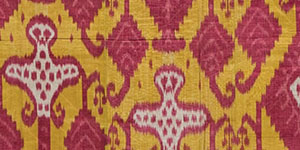
Fabric for kurak (patchwork) was seldom bought. At important family events, such as making an agreement, an engagement, a cradle ceremony, a child’s first haircut, or the funeral of a very old person, it was customary to distribute pieces of fabric to those in attendance. According to commonly-held beliefs, the magical properties of the fabric would help the recipient to achieve the same success as those who gifted the fabric or to live a long life as the person at whose funeral one received the fabric.
Cotton (karboz) was the most common fabric used for patchwork. Some of the other common fabrics used for kurak were: bakhmal (velvet of cotton warp/silk pile and weft), silk (silk warp and weft), adras (silk warp, cotton weft), and bekasab (cotton/silk striped), embroidered silk, and ikat. Ikat is a resist-dyed textile in which the design emerges from warp threads that are tied and dyed in pre-determined patterns prior to weaving. The densely spaced silk warp and cotton weft produce a warp-faced fabric. Called abr in Central Asia, derived from the Persian meaning “cloud,” it signifies the blurred edges of the motifs. It is an arduous process that requires thirty-seven steps from cocoon to finished product.
Traditionally, women sewed by hand, utilizing only a needle, thread, scissors, thimble, and a pin. It was only between 1907-1910 that Singer Sewing machines appeared in Khorezm, Uzbekistan, but they quickly spread throughout the oasis. Seamstresses were called tiküchi but the expression mashinchi soon came into use for those who dared to use the new invention. It was such a radical change that those who used sewing machines were labeled unbelievers. Nevertheless, their popularity grew and a special guild was established with its own patron saint.